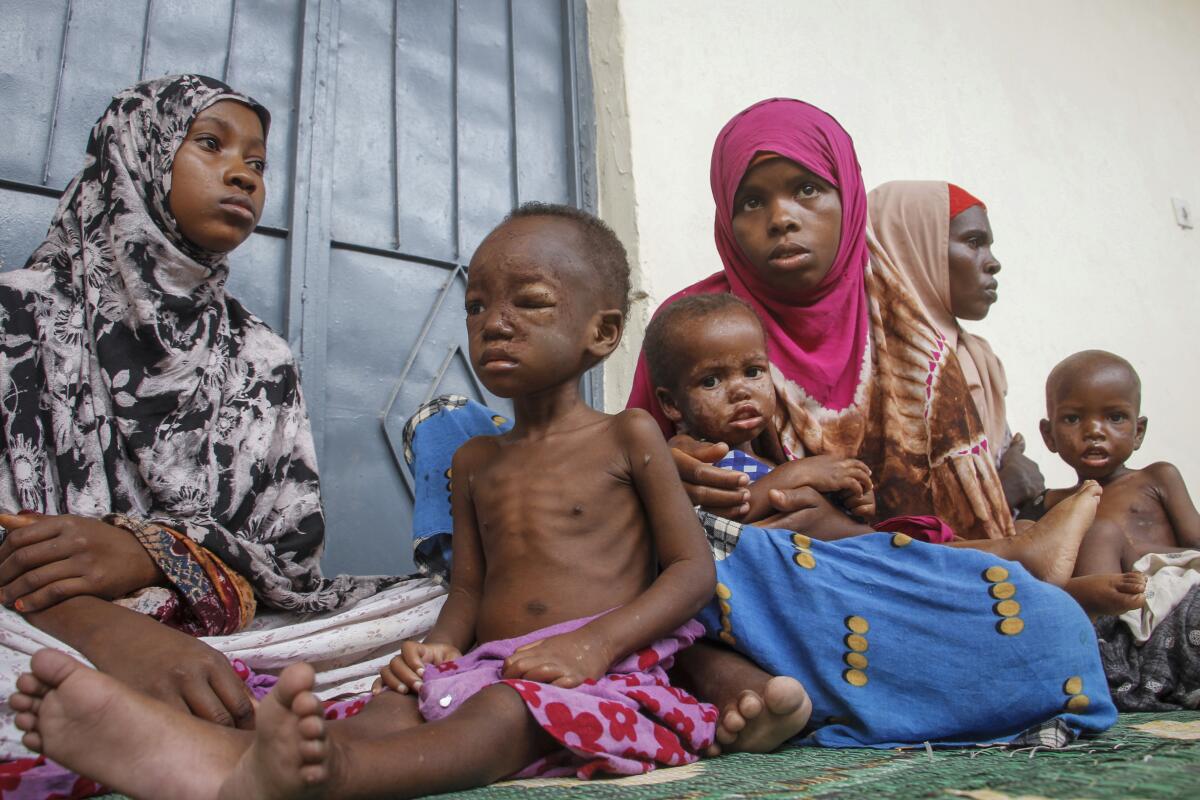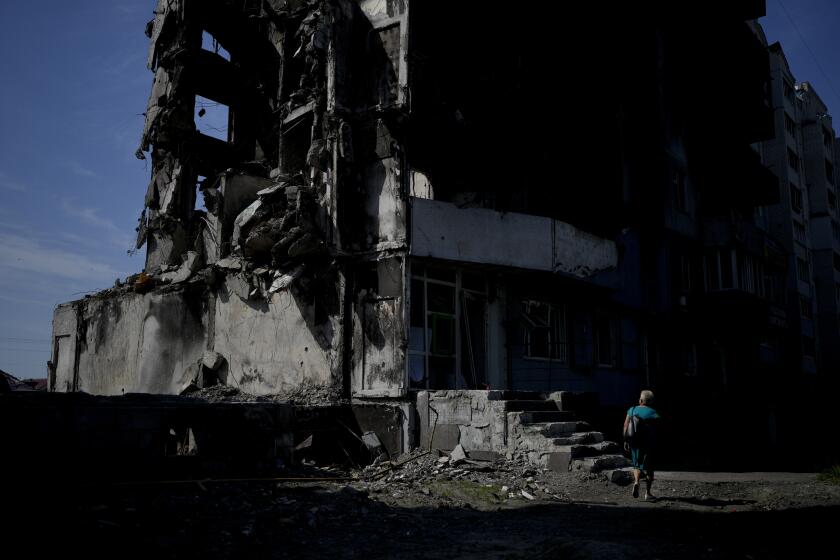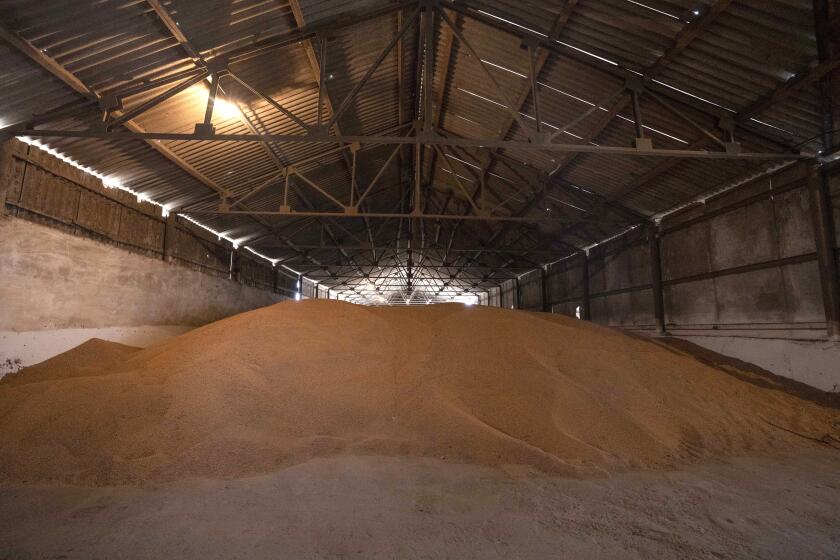Famine threatens wide swaths of world, now worsened by Ukraine war

- Share via
WASHINGTON — The scenes witnessed by journalists and humanitarian workers in recent months have been striking: In Sudan, swollen-bellied babies are looking for anything to eat. In Yemen, where warring parties have blocked humanitarian aid, hollow-eyed children and their mothers languish on the brink of death from starvation. In Ukraine, the elderly are collecting rancid rain runoff for drinking water.
Malnourishment and hunger were big problems even before Russia invaded Ukraine in February and cut off Europe’s breadbasket from its markets, sparking a flurry of dire warnings about the world’s food supplies. Dozens of countries across the globe are already suffering from devastating food shortages, so much so that the number of people facing starvation more than doubled in just the last two years, to 345 million, according to United Nations figures.
The causes are myriad: drought and flooding, and the interruption of supply chains triggered by the COVID-19 pandemic, especially in China. An estimated 20 wars or conflicts — the latest in Ukraine — have also seriously disrupted access to food and water.
“The current food security challenge that we’re facing [is] due to these three Cs: climate, COVID, and conflict,” said Ramin Toloui, assistant secretary of State for economic affairs, one of several Biden administration officials tasked to food-security issues.
The bleak situation drew the attention of powerful diplomats Friday when U.S. Secretary of State Antony J. Blinken and the foreign ministers of six other of the world’s largest economies met in Germany to map out plans for easing global food shortages. Few observers expect real solutions to emerge but hope the summit will highlight the crisis and boost funding for antihunger efforts.
The Biden administration has committed about $8.5 billion to emergency food assistance and related programs, focusing initially on the Horn of Africa, Yemen, Lebanon and Haiti, Blinken said.
“We hear all these numbers; we’ve all cited numbers of this growing food insecurity,” Blinken said in Berlin. “But what we know is this: We know that those numbers are people, real people, real lives, real livelihoods, mothers, fathers, children. ... As human beings, all of us have to be seized with this.”
Russian attacks are laying a curtain of fire across eastern Ukraine, where pockets of resistance are denying Moscow full military control of the region.
The U.N.’s World Food Program calculates that eight of the 10 largest food crises worldwide are being primarily driven by conflict — in Yemen, Ethiopia, Afghanistan and the Democratic Republic of Congo. Such wars force people from their homes into long desperate treks for safety. They devastate farms and wreak havoc on food distribution systems.
In Latin America, food scarcity is also driving tens of thousands of people to abandon parched or hurricane-leveled farms and migrate to the United States.
These were the disasters already in motion when Russia invaded Ukraine. Now, the U.N. says the Russian blockade of Ukraine’s Black Sea ports could lead 40 million more people to go hungry.
“We have to realize that this crisis that we’re experiencing now is not one that is going to go away in the next few weeks, months,” said Cary Fowler, the administration’s special envoy for global food security and the founder of the famous Norway-based “seed vault” that is preserving thousands of food species. “We have to … begin to think about this as an acute crisis that will last for a couple of years, unfortunately.”
The world’s confrontation with starvation intensified in February when Russia invaded its western neighbor, Ukraine, and blockaded the country’s Black Sea ports. Ukraine exports much of its grain, wheat and other foodstuffs from those ports, which are now menaced by Russia’s fleet. The blockade is no small matter — Ukraine is the world’s fifth largest exporter of wheat and corn, and a leading supplier of vegetable oil and fertilizer. By one estimate, nearly 25 million tons of grain is sitting in Ukrainian silos and warehouses, likely to rot.
Attempts to reroute the supplies overland would be expensive and extremely difficult, in part, because Ukrainian railway carriages would have to be refitted to work in other parts of Europe.
Third-party naval escorts have also been largely ruled out because it could lead to direct conflict with Russia, which is unlikely to let up its quarantine of Ukraine’s ports. Parts of the Black Sea have also been mined by Ukraine, adding another layer of danger.
Some experts contend the best solution is to arm Ukraine with longer-range artillery and aircraft, such as unmanned MQ-9 Reaper vehicles equipped with precision-guided missiles, so that it can take out Russian ships.
“You don’t have to have the most sophisticated weaponry, but they need the reach so they can push the Russians back without risking combat at sea,” said Bryan Clark, a former Navy official and submariner at the Hudson Institute, a Washington-based think tank.
Getting the grain and wheat out of Ukraine is only part of the problem. The war is ravaging fertile fields, disrupting harvests, destroying storage silos and killing farmers. When Russian bombs ruin a farm in eastern Ukraine, for example, there is a strong chance that family in Lebanon, which receives 80% of its grain from Ukraine, won’t have bread, aid workers say.
U.S. officials also say they have “credible” reports that Russia is stealing Ukrainian grain and selling it as its own.
The Kremlin contends that the food shortages are to be blamed on economic sanctions that the U.S. and most of the West have imposed on Russia. U.S. officials are quick to deny that, saying food and fertilizer are exempt from the sanctions.
Higher fuel costs also are hampering efforts to get food where it is needed, said Martin Frick, who heads the U.N.’s World Food Program office in Berlin. His agency’s operating costs have risen by $71 million per month; the shipping price of a single container of food or other aid has gone from $1,000 to $4,000 in recent months, he said.
“The number of people who need our help is skyrocketing,” Frick said in a telephone interview from Berlin, where he is attending the food crisis summit. “The funding is not. We basically have to take food from hungry people to give it to starving people.”
Treasury Secretary Janet L. Yellen says finance leaders need to look for ways to combat food insecurity, which Russia’s war in Ukraine has made worse.
To feed their populations, he said, countries facing food shortages should return to growing traditional crops — such as lentils in India, millet and sorghum in Africa and quinoa in Latin America — rather than focusing on producing more profitable agricultural commodities like coffee beans and cotton, both of which are resource intensive.
Caitlin Welsh, a veteran expert in global food security who heads that program at the Center for Strategic and International Studies in Washington, said hunger and famine have consequences for both health and politics.
Hungry people can be angry people, and the rising price of food or fuel have led to coups throughout history. The health effects of going hungry can be far-reaching and insidious, Welsh said.
“The sudden elevation in prices [of foodstuffs like bread] can make people shift from more nutritious food to items of lower nutrition,” she said. And for pregnant women and young children, that can cause lifelong disabilities, Welsh said.
More to Read
Get the L.A. Times Politics newsletter
Deeply reported insights into legislation, politics and policy from Sacramento, Washington and beyond. In your inbox three times per week.
You may occasionally receive promotional content from the Los Angeles Times.













